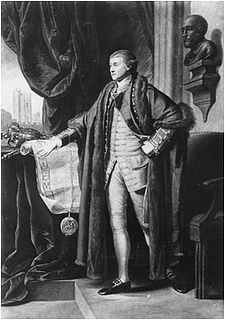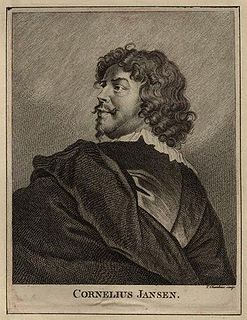Related Research Articles

John Stuart, 3rd Earl of Bute,, styled Lord Mount Stuart between 1713 and 1723, was a British nobleman who served as Prime Minister of Great Britain from 1762 to 1763 under George III. He was arguably the last important royal favourite in British politics. He was the first prime minister from Scotland following the Acts of Union in 1707 and the first Tory to have held the post. He was also elected as the first president of the Society of Antiquaries of Scotland when it was founded in 1780.

Demerara is a historical region in the Guianas on the north coast of South America which is now part of the country of Guyana. It was a Dutch colony until 1815 and a county of British Guiana from 1838 to 1966. It was located about the lower courses of the Demerara River, and its main town was Georgetown.

The landed gentry, or the gentry, is a largely historical British social class of landowners who could live entirely from rental income, or at least had a country estate. While distinct from, and socially below, the British peerage, their economic base in land was often similar, although in fact some of the landed gentry were wealthier than some peers, and many gentry were close relatives of peers, and it was not uncommon for gentry to marry into peerage. It is the British element of the wider European class of gentry. With or without noble title, owning rural land estates often brought with it the legal rights of lord of the manor, and the less formal name or title of squire, in Scotland laird.

John Freeman-Mitford, 1st Baron Redesdale, PC, KC, FRS, known as Sir John Mitford between 1793 and 1802, was an English lawyer and politician. He was Speaker of the House of Commons between 1801 and 1802 and Lord Chancellor of Ireland between 1802 and 1806.

Richard Grosvenor, 1st Earl Grosvenor, known as Sir Richard Grosvenor, Bt between 1755 and 1761 and as The Lord Grosvenor between 1761 and 1784, was a British peer, racehorse owner and art collector. He was created Baron Grosvenor in 1761 and in 1784 became both Viscount Belgrave and Earl Grosvenor.

Cornelius Johnson or Cornelis Janssens van Ceulen was an English painter of portraits of Dutch or Flemish parentage. He was active in England, from at least 1618 to 1643, when he moved to Middelburg in the Netherlands to escape the English Civil War. Between 1646 and 1652 he lived in Amsterdam, before settling in Utrecht, where he died.

Sir Charles Frederick KB FRS was a British politician who sat in the House of Commons from 1741 to 1784.

Sir Edward Cust, 1st Baronet, KCH was a British soldier, politician and courtier.
The Weld-Blundell family are a cadet branch, arisen in 1843, of the English Welds of Lulworth. It is an old gentry family which claims descent from Eadric the Wild and is related to other Weld branches in several parts of the United Kingdom, notably from Willey, Shropshire and others in the Antipodes and America. A notable early Weld was William de Welde, High Sheriff of London in 1352, whose progeny moved in and out of obscurity.

Lieutenant General John Huske was a British military officer, whose active service began in 1707 during the War of the Spanish Succession, and ended in 1748.

Daniel Charles, Count O'Connell was the uncle of Daniel O'Connell "the Liberator." He was from a noble family of Derrynane House, County Kerry, Ireland, but because of the Penal Laws (Ireland) of the time, which forbade a Catholic to have any education or profession, he, like many other ambitious young Irishmen, went to the Continent for an education, and remained abroad. He entered the service of the king of France in the Royal Swedish Regiment in 1761, and in 1769 was transferred to Lord Clare's Regiment of the Irish Brigade (French) and served in Europe and Mauritius until 1778. Then he was appointed Lieutenant-Colonel and transferred back to the Royal Swedish Regiment, with which he saw action at the siege of Port Mahon and at the Great Siege of Gibraltar. "At Gibraltar he was on board one of the famous floating batteries and was severely wounded." He was later appointed Colonel Commander of the Régiment de Salm-Salm, and was created a Chevalier of the Order of Saint Louis. He also was appointed to a military committee charged with revising French infantry tactics.

The Stuart period of British history lasted from 1603 to 1714 during the dynasty of the House of Stuart. The period ended with the death of Queen Anne and the accession of King George I from the German House of Hanover.

Edward Rudge was an English botanist and antiquary.

General Sir John Ormsby Vandeleur was a British Army officer who fought in the French Revolutionary and Napoleonic wars.

Nicolson Calvert was an English Whig politician.
Lt.-Gen. Hay MacDowall was a Scottish officer in the British Army who was the sixth General Officer Commanding, Ceylon. He was appointed on 19 July 1799. He was succeeded by David Douglas Wemyss. Fort MacDowall in Matale was named due to his involvement during Kandyan Wars. Only the remnants of gateway and portion of the ramparts are exist today.

Henry Dawkins II was a Jamaican plantation and slave owner and Member of the Parliament of Great Britain (MP).
John Luard (1790–1875) was a British Army officer and author of History of the Dress of the British Soldier
The Royal North Gloucestershire Militia (RNGM), later the 4th (Militia) Battalion, Gloucestershire Regiment was a Militia regiment raised in the county of Gloucestershire in the West of England. From its formal creation in 1763 the regiment served in home defence and overseas garrisons in all of Britain's major wars until 1908.

Marquois scales are a mathematical instrument that found widespread use in Britain, particularly in military surveying, from the late 18th century to World War II.
References
- 1 2 "To Officers and Young Gentlemen intended for the Army" . The Public Advertiser. January 18, 1766. p. 3. Retrieved May 13, 2016– via Newspapers.com.
- ↑ "Scientific Instrument Society 25th Anniversary Exhibition: Marquois Scales". Museum of the History of Science . Retrieved May 13, 2016.
- 1 2 "Mr. Marquois's Most Useful Pair of Scales". Tools and Trades History Society. Retrieved May 13, 2016.
- ↑ Sheppard, F. H. W. (1973). Survey of London. 37. London: London County Council. pp. 276–297. Retrieved May 13, 2016– via British History Online.